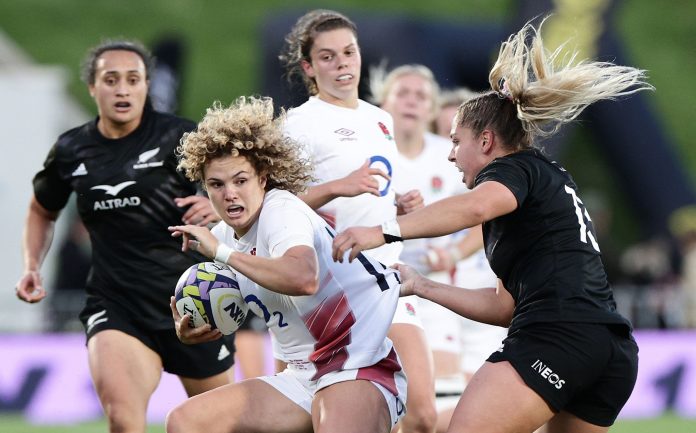The RFU has presented the names of the 32 Red Roses to receive contracts.
Here is my version of the list:
Backs
Holly Aitchison (Bristol Bears)
Jess Breach (Saracens)
Abby Dow (Trailfinders)
Zoe Harrison (Saracens)
Tatyana Heard (Gloucester-Hartpury)
Natasha Hunt (Gloucester-Hartpury)
Megan Jones (Leicester Tigers)
Ellie Kildunne (Harlequins)
Claudia MacDonald (Exeter Chiefs)
Lucy Packer (Harlequins)
Helena Rowland (Loughborough Lightning)
Emily Scarratt (Loughborough Lightning)
Ella Wyrwas (Saracens)
13
Forwards
Zoe Aldcroft (Gloucester-Hartpury)
Lark Atkin-Davies (Bristol Bears)
Sarah Beckett (Gloucester-Hartpury)
Sarah Bern (Bristol Bears)
Hannah Botterman (Bristol Bears)
Mackenzie Carson (Gloucester-Hartpury)
Kelsey Clifford (Saracens)
Amy Cokayne (Leicester Tigers)
Liz Crake (Trailfinders)
Maddie Feaunati (Exeter Chiefs)
Rosie Galligan (Saracens)
Sadia Kabeya (Loughborough Lightning)
Alex Matthews (Gloucester-Hartpury)
Maud Muir (Gloucester-Hartpury)
Cath O’Donnell (Loughborough Lightning)
Marlie Packer (Saracens)
Connie Powell (Harlequins)
Morwenna Talling (Sale Sharks)
Abbie Ward (Bristol Bears)
19
There are two new names, Maddie Feaunati and Liz Crake. Among the many not to be found are Amber Reed, Poppy Cleall and Emma Sing.
The balance between forwards and backs lies at 19/13, about as extreme as you are likely to find in a group of this size.
That can mean many things, for example: John Mitchell believes in having and maintaining forward domination, somewhat different from the emphasis laid on expansive back-play; he and his staff know they have outstanding backs at their disposal, so no need to hunt further; with only 13 backs named, full practice sessions can’t happen without the presence of others, presumably the awkwardly named ‘transition contracted players’.
They are: Maisy Allen (Exeter Chiefs), Katie Buchanan (Exeter Chiefs), Grace Clifford (Loughborough Lightning), Steph Else (Gloucester-Hartpury), Lizzie Hanlon (Exeter Chiefs), Lilli Ives Campion (Loughborough Lightning), Nancy McGillivary (Exeter Chiefs), Mia Venner (Gloucester-Hartpury)
None of those eight players is a surprise, though it’s that category that must provide the most potential alternatives. The PWR is doing one of its most important jobs is throwing up names of highly promising players who would otherwise have remained little remarked beyond their home clubs.
One of the punts that Simon Middleton took when in charge was to pick Mia Venner at the age of just 17. In the 2020 Wales match she was brought on field for her debut in the closing minutes, only to suffer the experience of dallying over a clearance kick and conceding a try. It’s taken a while for her to find favour again.
Age
This is the one ever-present factor selectors have to deal with. It helps in part to explain the absence of two of the three names mentioned above, Cleall and Reed. Both are the wrong side of 30. Reed, now 33, first played for England in 2012 and was a member of the 2014 World Cup-winning squad. Cleall is 31; in 2020 she was named the Six Nations Player of the Championship.
Against those hard decisions we see the names of Marlie Packer and Emily Scarratt retained. Nobody will be surprised; the only worry was and remains, when will they see fit to hang up their boots? Most probably after the RWC. It has been strange finding Scarratt sitting on the bench, but when she has been allowed to take part, her contributions have been positive and varied. She is mistress of so many different skills that her presence over the final minutes of a tight game can be absolutely critical.
Packer has shown few signs of slowing down, but the day must dawn.
A third omission, Sing, is quite a different matter. Any number of Gloucester supporters will be tearing their hair out at the news. It won’t satisfy them to argue that England already have any number of players who can wear the 15 shirt with distinction. She is 23, so may yet regain favour.
7s v 15s
This paragraph simply had to be included! The presence of both Jones and Kildunne on the list – no surprise in themselves – indicates that the management is happy with them attempting to combine both game formats.
It will be fascinating to see precisely how many players appear at both the Olympics and the World Cup, and how well they transition from the one to the other. All the major nations, Australia, Canada, England, France and New Zealand, are likely to feature under this heading.
Versatility
This is one of England’s greatest strengths. The only players unlikely to play away from their prime position are the specialists, hookers and scrum-halves; and even there, Amy Cokayne would dearly love to wear 10 for England.
Proof comes as we rewatch some of the team’s best tries in the 2024 Six Nations. There we can spot players turning up way out of position, but performing tasks that the specialists can only admire. Two examples: Abby Dow ripping the ball out of an opponent’s grasp as if she were Marlie Packer, and Sarah Bern marauding through midfield, to give a perfectly timed off-load to her supporting winger.
Club Allocations
Bristol Bears 5; Exeter Chiefs 2; Gloucester-Hartpury 7; Harlequins 3; Leicester Tigers 2; Loughborough Lightning 4; Sale Sharks 1; Saracens 6; Trailfinders 2.
These numbers mirror final PWR positions tolerably well.
Fixtures
Out-of-season test matches now take on a different complexion, brought about by the addition of WXV to the calendar. So this late summer sees two demanding matches, against France (7 September) and New Zealand (14 September).
Since England will be meeting (if not playing against) both of them, starting a fortnight later in Canada, there is an element of déjà vu about this schedule. But nations all over the globe are hunting for meaningful encounters; that means, against sides that will really test their ability. That is a lesson that the Black Ferns have learned to their cost. They are preparing with gusto for their Twickenham match. If they win there, it will be a first – quite a strange thought, when we consider Eden Park as the great fortress where visiting teams fear to tread.









